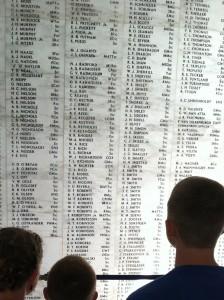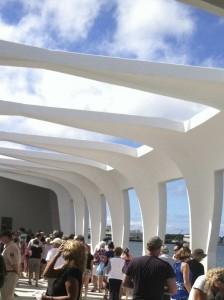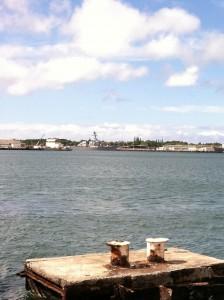
It is hard to predict when the sadness and solemnity will hit you when you visit Pearl Harbor. For me it was when we set out on the Navy vessel across the channel that on a December morning in 1941 turned into hell on earth, a bloody chaos of explosions and smoke and fire and bombs.
December 7 is Pearl Harbor Day, and 2014 will mark the 73rd anniversary of the attack that brought the United States into World War II. Ceremonies will be held at the Pearl Harbor Historical Sites on the island of Oahu in Hawaii, honoring the more than 2,000 American servicemen killed that day as well as those who survived the destruction.
The ceremonies—another purpose of which is to keep the memory of these events alive to younger generations of Americans—are a poignant and emotionally charged experience for those who attend. But a trip to Pearl Harbor is well worth it any time of the year.
We went in August as part of a family vacation filled with the usual Hawaiian pleasures of beaches, sun, snorkeling, surfing and shave ice. I had been there as a boy, and now as a grown man I wanted my three children to see the place that had meant so much to their late grandfather, a Navy battleship radio technician who had come through Pearl Harbor on his way to fighting the Japanese in the South Pacific.
More than 1.5 million people a year visit the Pearl Harbor Visitor Center, which includes two museums and outdoor exhibits. Also part of this national monument area are the Pacific Aviation Museum, the Battleship Missouri Memorial and the USS Bowfin Submarine Museum—all sites of historical significance and worthy of your time.
But for our family, probably like most people, the emotional centerpiece of our trip began with a sensitive and well-made 25-minute documentary narrated by actress Jamie Lee Curtis. This film, which describes the events leading up to the attack, the attack itself and its aftermath, is shown in the Pearl Harbor Memorial Theatre. From there we quietly boarded a United States Navy vessel that took our group across the water to the USS Arizona Memorial.

Less than 200 feet long, the memorial is a radiant white structure that is as beautiful as it is simple. I looked over at my family as we approached. No one was saying a word. Nothing needed to be said.
Designer Alfred Preis said his aim was to create an atmosphere of “serenity” in which people could tune into their own feelings in their own way. Mission accomplished. Stepping from the boat onto the memorial, we were left to ourselves to contemplate what we were seeing: the rusted remnants of the USS Arizona that were still sticking above the water and below the surface, the darkened hull of the sunken battleship.

After an appropriate interval, visitors are asked to leave the memorial, get back on a Navy boat, and return to the visitor center. The entire experience takes about 75 profoundly well-spent minutes, including the movie. Tickets are free. Reservations are strongly recommended. Some walk-up tickets are made available each day, but the best strategy is to go to the World War II Valor in the Pacific website, operated by the National Park Service, and book the day and time of your tour as soon as you know when you will be in Honolulu.

